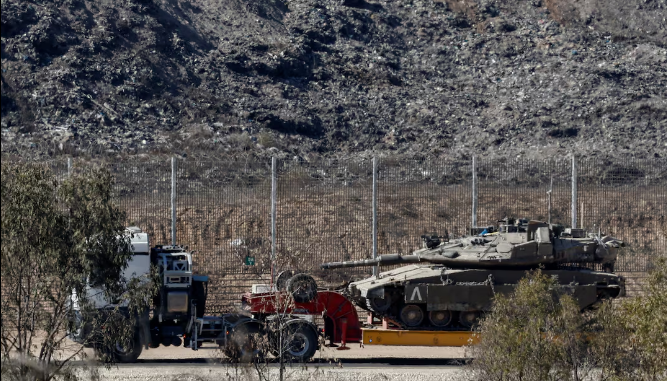
A truck transports a tank on the Israeli side of the border with Gaza, in Israel, October 19, 2025. Photo: Reuters
Published October 26, 2025
A US-backed ceasefire is in force between Israel and the Palestinian militant group Hamas just over two years since the war in the Gaza Strip began, but each side has accused the other of violations.
On October 25, 2025, the Israeli military conducted a “targeted strike” in central Gaza, claiming to have targeted a member of the Palestinian Islamic Jihad (PIJ) accused of planning an attack on Israeli troops. The strike reportedly involved a drone targeting a vehicle, resulting in four injuries but no confirmed fatalities. Additionally, Israeli tanks shelled parts of eastern Gaza City.
The PIJ denied the Israeli accusation, labeling it a “mere fallacious allegation,” and did not confirm whether any of its members were killed. This incident occurred amidst a U.S.-brokered ceasefire between Israel and Hamas, which has been in effect for over two years. Both parties have accused each other of violations, contributing to ongoing tensions in the region.
In a related development, Israel has allowed Egyptian officials into Gaza to assist in locating the remains of hostages taken during the Hamas-led attack on October 7, 2023. Despite Hamas’s pledge to return all abducted hostages, the remains of 13 individuals are still unaccounted for.
The Israeli military’s recent targeted strike in central Gaza on October 25, 2025, has elicited a range of public and political reactions, both within Israel and internationally, amid ongoing ceasefire tensions.
🇮🇱 Israeli Government and Military
The Israeli Defense Forces (IDF) stated that the airstrike targeted a member of the Palestinian Islamic Jihad (PIJ) who was allegedly planning an imminent attack on Israeli troops. The operation was reportedly conducted with prior coordination with U.S. Central Command (CENTCOM), though not as a formal request. Prime Minister Benjamin Netanyahu emphasized that Israel acts independently in its security decisions, despite the ceasefire agreement with Hamas.
The IDF’s actions come after a series of escalations, including a significant bombing campaign on October 21 that dropped 153 tonnes of bombs on Gaza, signaling a continuation of military operations despite the ceasefire.
 Implications
Implications
The targeted strike by Israel has broader implications that extend beyond the immediate military and humanitarian effects. These implications span regional security, diplomacy, political dynamics, and long-term stability.
1. Regional Security Implications
-
Escalation Risk: Even a targeted strike can trigger retaliatory attacks from Palestinian Islamic Jihad (PIJ) or other militant factions, raising the risk of a larger flare-up in violence.
-
Border Stability: Repeated strikes and counteractions may destabilize the Gaza-Israel border, affecting both civilian populations and military preparedness.
-
Militarization of Tactics: Israel’s use of precision drone strikes and tank shelling demonstrates a shift toward high-tech, targeted operations, which may influence tactics on both sides.
2. Political and Strategic Implications
-
Domestic Politics in Israel: The Israeli government must balance public demand for security with international scrutiny, potentially affecting political standing and policy decisions.
-
Palestinian Faction Dynamics: PIJ’s response to the strike can influence intra-Palestinian politics, shaping perceptions of strength and legitimacy among Gazans and rival factions.
-
Deterrence Signaling: Israel’s precision strikes serve as a deterrent to other militant factions contemplating attacks on Israeli territory, signaling capability and resolve.
3. Diplomatic and International Implications
-
Ceasefire Fragility: The incident highlights the tenuous nature of the U.S.-brokered ceasefire with Hamas. Repeated violations can weaken trust and complicate diplomatic mediation.
-
Role of Mediators: Egypt’s involvement in hostage recovery and coordination underscores its position as a regional mediator, but also emphasizes the complexities of peacebuilding.
-
Global Perception: International actors—including the UN, U.S., EU, and human rights organizations—monitor these operations closely, influencing aid, sanctions, or diplomatic pressure.
4. Humanitarian and Societal Implications
-
Civilian Impact: Even limited strikes exacerbate trauma, displacement, and disruption to essential services in Gaza, creating long-term societal challenges.
-
Media and Public Opinion: Reports of civilian casualties or property damage can shape global public opinion, affect international support, and influence the narrative around both sides.
-
Aid Delivery Challenges: Humanitarian organizations may face logistical difficulties in delivering aid due to security risks and damaged infrastructure.
5. Long-Term Stability Implications
-
Cycle of Violence: Targeted strikes and retaliations can create a self-perpetuating cycle, making long-term peace harder to achieve.
-
Strategic Calculations: Both Israel and Palestinian factions may adjust their strategies based on these operations, potentially leading to more frequent or preemptive actions.
-
Negotiation Leverage: Each strike influences the bargaining positions of both sides, affecting potential negotiations on ceasefire terms, hostage releases, and humanitarian access.
 Overall Takeaway:
Overall Takeaway:
The October 25, 2025 Israeli military strike in central Gaza highlights the complex interplay of security, diplomacy, and humanitarian concerns in the region. While the operation targeted a member of the Palestinian Islamic Jihad (PIJ) to prevent potential attacks on Israel, the repercussions extend far beyond the immediate military objective.
Key Points:
-
Military Implications: Israel continues to rely on precision strikes and drone operations as a deterrent against militant threats, while the risk of retaliatory actions remains.
-
Political Reactions: Both Israeli and Palestinian factions, as well as international actors, have expressed concern, reflecting the fragile nature of the two-year U.S.-brokered ceasefire.
-
Humanitarian Impact: Civilians in Gaza continue to bear the brunt of conflict, facing injuries, trauma, and infrastructure disruption, which complicates aid delivery.
-
Diplomatic and Regional Implications: The strike underscores the tenuousness of ceasefire agreements, highlights Egypt’s mediation role, and draws international scrutiny to Israel’s military actions.
-
Future Outlook: A cycle of targeted strikes, retaliations, and diplomatic mediation is likely to continue, with lasting peace remaining uncertain.
Overall: The strike serves as a stark reminder of the delicate balance between national security, humanitarian responsibility, and international diplomacy in the Israel-Gaza conflict. Each military action reverberates across political, societal, and regional spheres, emphasizing the urgent need for sustainable conflict resolution strategies.
SOURCES: REUTERS – Israeli military says it conducted ‘targeted strike’ in central Gaza
THE BUSINESS STANDARD – Israeli military says it conducted ‘targeted strike’ in central Gaza
THE STRAITS TIMES – Israeli military says it conducted ‘targeted strike’ in central Gaza
CHANNEL NEWS ASIA – Israeli military says it conducted ‘targeted strike’ in central Gaza








Be the first to comment